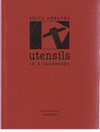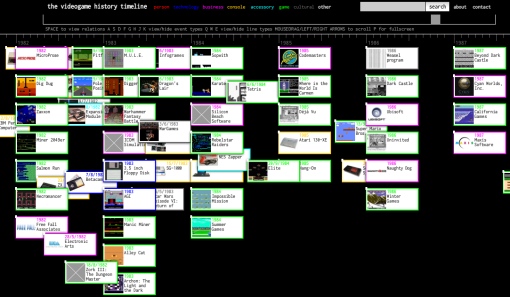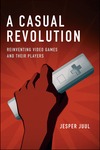Here’s an interview with me, on YouTube, focusing on ppg256.
In(ter)ventions in Medias Res
I’m here in Banff (in Alberta, Canada) at the cutting edge, or maybe the precipitous edge, or, as I’d prefer to think, the connecting edge. The occasion is In(ter)ventions: Literary Practice at the Edge: A Gathering, organized by Steven Ross Smith.
The presenters include: Charles Bernstein, Jen Bervin, Christian Bök, J.R. Carpenter, Maria Damon, Ram Devineni, Craig Dworkin, Al Filreis, Christopher Funkhouser, Kenneth Goldsmith, D Kimm, Larissa Lai, Daphne Marlatt, Nick Montfort, Erin Moure, Lance Olsen, Stephen Osborne, Kate Pullinger, Stephanie Strickland, Steve Tomasula, Fred Wah.
The presentations (which include critical papers, but also many readings, screenings, performances, and artists’ talks) have been provocative and have unfolded new types of beauty and new understandings of process.
On Thursday, February 18, I was honored to join Larissa Lai and Chris Funkhouser as part of the opening reading. I read from Implementation (a collaboration with Scott Rettberg) and ppg256, concluding with the premiere of a new poety generator in this series, ppg256-5:
perl -le '@a=split/,/,"conceptual,digit,flarf,maximal,modern,pixel,quiet,real";sub f{pop if rand>.5}sub w{$a[rand@a]}{print f("post").w."ism ".w."s ".f("the ").w."\n".(" "x45)."WHAT DOES ppg DO?";$a[rand@a]=~s/[aeio]/substr("aeio",rand 4,1)/e if $l++>5;sleep 5;redo}'
As I explained in my talk the next morning, this program is based on a section in the middle of Tristan Tzara’s February 1921 Dada Manifesto, a section that begins:
cubism constructs a cathedral of artistic liver paste
WHAT DOES DADA DO?expressionism poisons artistic sardines
WHAT DOES DADA DO?
If you run ppg256-5 (which is the real way to experience the program) it might begin:
postmodernism flarfs digit
WHAT DOES ppg DO?realism reals the conceptual
WHAT DOES ppg DO?
Because this section of Tzara’s manifesto ends “50 francs reward to the person who finds the best way to explain DADA to us,” so I concluded by presentation similarly, offering a 50 character reward for the person who finds the best way to explain ppg to us. Chris Funkhouser said, “It does a lot with a little.” John Cayley offered that “ppg combines atoms of language.” These aren’t bad explanations, but the most impressive so far has been from Travis Kirton, who, without having any previous experience programming in Perl, created and sent me this modified version of ppg256-5:
perl -le '@a=split/,/,"illmn,imgn,ltr,mut,pxl,popl,strlz,pnctu,typfc,poetc,glmr,idl,ion,cptl,cpsl,cvl,atom,pltc,txtul,erotc,rvl";sub f{pop if rand>.5}sub w{$a[rand@a]}{print f("de").f("over").w."izes ".w."ation".f("s")."\n".(" "x45)."IS WHAT ppg DOES!";sleep 5;redo}'
A run of this may begin by outputting:
deltrizes ionation
IS WHAT ppg DOES!deoverltrizes mutations
IS WHAT ppg DOES!
I’ll have to see if anything can top that and earn the 50-character reward.
Here’s what’s being said on Twitter about the conference. I’ve found that one participant, Claire Lacey, has been writing about In(ter)ventions on her blog poetactics. Finally, here are just a handful of memorable (mis)quotes to give you another impression, however slanted, of this gathering:
Stephanie Strickland: “The front of your wave is the back of someone else’s.”
Steve Tomasula, in reference to Magritte: “No one ever says that this isn’t a cigarette:
 ”
”
My mishearing of Maria Damon, who was discussing healthy eating with someone as we were descending a staircase: “You need a multi-prawn strategy.”
D Kimm: “We are always unknown to someone.”
Update: Steven Osborne has just launched a blog with a post about the conference.
“Geração sobre a fala” / “My Generation about Talking”
“Geração sobre a fala” (“My Generation about Talking,” Nick Montfort) Tradução para o português, Cicero Inacio da Silva.
“My Generation about Talking,” a text generator which I first presented at the Software Studies Workshop on May 21, 2008, is now available in Portuguese translation, thanks to Cicero Inacio da Silva. It was made for use in a presentation, but the program is set up to allow a user to play the entire presentation or to access any of the fifteen individual voices, each of which affirms repeatedly in some way.
The program is in Python and will run from the command line in OS X and on many Linux systems. It will run on Windows after Python for Windows has been installed.
For instance, to run the English version of this program on OS X:
- Download yes_voices.py to the desktop; if you download it to another location, move the file to the desktop.
- Start the Terminal application and open a terminal window. An easy way to do this: Click on the Spotlight magnifying glass in the upper left, type “terminal”, and select the Terminal application. A window will open.
- In the terminal window, type “cd Desktop” and press return to change directories to the desktop.
- Type “python yes_voices.py” and press return.
Writing Instruments for Class Today

DAC09 Proceedings Now Online
Proceedings of the Digital Arts and Culture Conference, 2009 are now online. The conference was a great success; DAC continued to lead the way in the culturally engaged study of digital art and media. Many thanks go to Simon Penny, who was director of the conference, and others at UIC: Ward Smith, Liz Losh, and Sean Voisen. The theme leaders for this conference put together very strong series of papers that were both focused and relevant. I hope those of you who didn’t make it to Irvine will visit the proceedings and see a bit of what happened at the latest instance of this extraordinarily rich series of gatherings, where the study of video games, digital art, digital literature, performance, and the cultural aspects of online and computing experience have been explored so well over the years.
Purple Blurb, Spring 2010
I’m delighted to announce our Spring 2010 Purple Blurb events:
Video
Roderick Coover & Nitin Sawhney
Monday, March 1
5:30pm-7pm
Poetry
Stephanie Strickland
Monday, March 8
5:30pm-7pm
Interactive Fiction
Jeremy Freese & Emily Short
Monday, March 29
5:30pm-7pm
Poetry
John Cayley & Daniel C. Howe
Wednesday, April 28
7:30pm-9pm
All events are in MIT’s 14E-310.
Note that the first three events begin earlier (5:30pm) than in semesters past, while the final event this semester begins later (7:30pm).
Please also note (or recall) that 14E is the east wing of Building 14, the building which also houses the Hayden Library. This is *not* building E14, the new Media Lab building.
March 1
RODERICK COOVER
Canyonlands (www.unknownterritories.org) is a film and interactive documentary about the works of the novelist and essayist, Edward Abbey (1927-1989). Abbey worked as a seasonal ranger and forest lookout in Western parks and forest-lands, wrote in praise of wilderness, and called attention to the destruction of the desert landscape. His descriptions of eco-sabotage in his novel The Monkey Gang were an inspiration for the formation of the environmentalist organizations such as EarthFirst! Canyonlands takes users into a virtual representation of the Colorado River and Utah canyonlands. There, users will follow Abbey’s road and fascinating side routes as they weave their way through history.
Roderick Coover makes panoramic interactive environments, collaborative streaming visual poems, and multimedia documentary projects about histories, narratives, and the sense of place. Some titles include Unknown Territories (Unknownterritories.org), Cultures in Webs (Eastgate Systems), From Verite to Virtual (D.E.R), The Theory of Time Here (Video Data Bank), The Language of Wine (RLCP), and Something That Happened Only Once (RLCP) among others. An associate professor of film and media arts at Temple University, Roderick Coover has received awards from USIS-Fulbight, a LEF Foundation, and the Mellon Foundation, among others. URL: http://www.roderickcoover.com
NITIN SAWHNEY
Strawberries, Roosters and the Chocolate Seas is an upcoming feature-length documentary. It is a personal journey into the heart of Gaza using a satirical and poetic rendering of everyday life and the extraordinary events witnessed by the filmmaker, during his visit there one year after the devastating 22-day siege in January 2009. The film, shot during two intense weeks in January 2010, includes interviews with fishermen, farmers, physicians, teachers, and working professionals, interspersed with footage that captures dramatic events like the large convoys of aid arriving in Gaza despite the blockade, tunnels used to smuggle goods, hip hop bands striving for creative expression, and the floods that turned Gaza’s seashore from deep blue to chocolate.
Nitin Sawhney is a research fellow in the Program in Art, Culture and Technology in the Department of Architecture at MIT. He co-founded the Voices Beyond Walls initiative for digital storytelling in Palestinian refugee camps. The program was founded in 2006, when pilot digital media and storytelling workshops were first conducted in the Balata and Jenin refugee camps in the West Bank. Since then local and international volunteers have conducted nearly a dozen workshops in six different refugee camps. See: http://www.voicesbeyondwalls.org Sawhney was selected as a Visionary Fellow with the Jerusalem 2050 Program: http://envisioningpeace.org/visions/media-barrios He has recently returned from a trip to Gaza and is sharing footage from a documentary he is co-producing: http://www.GazaRoosterFilms.com
March 8
STEPHANIE STRICKLAND
Strickland will read from four collaborative digital poems created over the past twelve years, each of which uses the screen differently: V: Vniverse, Ballad of Sand and Harry Soot, Errand Upon Which We Came, and slippingglimpse.
Stephanie Strickland is a print and hypermedia poet who, in addition to having written the digital poems mentioned above, has published five books: Zone : Zero, V: WaveSon.nets / Losing L’una, True North, The Red Virgin: A Poem Of Simone Weil, and Give the Body Back.
March 29
JEREMY FREESE
Violet is an interactive short story about romance and procrastination in which the main character is struggling to complete his dissertation. The things that happen in the simulated graduate student office are narrated to the player by the (imaginary) voice of the main character’s Australian girlfriend. Violet won several XYZZY awards in 2008, including the award for Best Game, and was the winner of the 2008 Interactive Fiction Competition.
Jeremy Freese is a professor in the Department of Sociology, School of Communication, and Institute for Policy Research at Northwestern University.
EMILY SHORT
Alabaster is a fractured fairy tale by John Cater, Rob Dubbin, Eric Eve, Elizabeth Heller, Jayzee, Kazuki Mishima, Sarah Morayati, Mark Musante, Emily Short, Adam Thornton, and Ziv Wities, illustrated by Daniel Allington-Krzysztofiak. This interactive fiction is an experiment in open authorship. The introduction to the story was written and released by Short in 2008. The game is implemented in Inform 7 using a conversation system, developed by Short, that will be released for general use by Inform 7 developers. There are eighteen possible endings to Alabaster.
Emily Short is author of or collaborator on more than two dozen interactive fictions, including Galatea (winner of Best of Show in the 2000 IF Art Show) and Savoir Faire (XYZZY Award for Best Game and in other categories, 2002) and Floatpoint (winner of the 2006 IF Competition) along with other XYZZY award-winning games: Metamorphoses (2000), Pytho’s Mask (2001), City of Secrets (2003), and Mystery House Possessed (2005). Short, who is a classicist and a scholar of attic drama, has worked on the development of Inform 7, has reviewed dozens of games, and writes the column “Homer in Silicon” for GameSetWatch.
April 28
The Readers Project is a collection of distributed, performative, quasi-autonomous poetic ‘Readers’ — active, procedural entities with distinct reading behaviors and strategies. We release these Readers onto inscribed surfaces that may be explicitly or implicitly, visibly or invisibly, constituted by their texts. Over time, the Readers will address themselves to a wide range of material — from conventional found texts, through poetic reconfigurations of appropriated (fairly-used) sources, to original compositions by the project’s collaborators, and so on.
Designed to support the creation of novel works of digital literature, Howe’s RiTa library, in which The Readers Project is implemented, provides a unique set of tools for artists and writers working in programmable media. Combining features of natural language processing, computational stylistics, and generative systems, RiTa enables a range of tasks, from statistical methods, to grammar-based generation, to linguistic database access (e.g., WordNet), to text-mining, to text-to-speech, to image, audio, & animation, all in real-time. RiTa is free and open-source and integrates with the popular Processing environment for digital arts programming.
JOHN CAYLEY
John Cayley writes digital media, particularly in the domain of poetry and poetics. Recent and ongoing projects include The Readers Project with Daniel Howe, imposition with Giles Perring, riverIsland, and what we will. Information on these and other works may be consulted at http://programmatology.shadoof.net. Cayley is a visiting professor at Brown University, Literary Arts Program.
DANIEL C. HOWE
Daniel C. Howe is a digital artist and researcher whose work explores the intersections of literature, computation, and procedural art practice. He recently received his PhD (on generative literary systems) from the Media Research Lab at NYU and was awarded a ‘Computing Innovations’ fellowship from the National Science Foundation for 2010. He currently resides in Providence, RI where he teaches at Brown and RISD, and is a resident artist at AS220. His site: http://mrl.nyu.edu/~dhowe/
100,000,000,000,000 Sports
Well, not quite that many, but 10,000,000 isn’t too shabby…
In this adaptation of Raymond Queneau’s 100,000,000,000,000 Poems, the rules of 10 sports (football, polo, water polo, lacrosse, ice hockey, table tennis, basketball, rugby, the Kirkwall ba’ and beach volleyball) are divided into their constituant elements (duration, playing area, objective, players per team, attire, ball and method of play/restrictions) in such a way that they can be reassembled without contradicting each other.
Utensils in a Landscape
Searching for something suitably disruptive in the landscape of Australia, where Jacket is rooted, I found this. The first poem is made from sometimes misquoted bits of The Book of Common Prayer and Burroughs’s “The Cut-Up Method …” With technical and abstract language, folklore, Mallarmé, and guy-on-guy action, the book offers all sorts of utensil viewing. And later, in “but me,” this reflection:
My project, which began in
one room of the abyss, soon spread toward a perimeter
you can imagine, should you be inclined to do so.
I usually prefer projects in which sources are altered sparingly and systematically – Craig Dworkin’s “Legion” is a brilliant example. These approximate centos work, though. The invented language weaves with the appropriated, making it seem that Edwards could have done it all with his pen – or all with his scissors.
Up Above Once Again
 I’m back from a nice slice of summer in Sydney, Australia. I spoke at the University of New South Wales when I was there, gave two talks at the Powerhouse Museum in connection with their “The 80s Are Back” exhibit, and was one of the three judges of the Global Game Jam Sydney. The people who participated in that event did some incredible work – congratulations to all. Here’s some video of me, at the Powerhouse Museum, on interactive fiction and on indie and 80s videogames.
I’m back from a nice slice of summer in Sydney, Australia. I spoke at the University of New South Wales when I was there, gave two talks at the Powerhouse Museum in connection with their “The 80s Are Back” exhibit, and was one of the three judges of the Global Game Jam Sydney. The people who participated in that event did some incredible work – congratulations to all. Here’s some video of me, at the Powerhouse Museum, on interactive fiction and on indie and 80s videogames.
Videogame Timeline
Mauricio Giraldo Arteaga has completed a beta version of his extensive and well-designed Videogame Timeline. He’s also written a blog post about the project, in Spanish. (Update: Mauricio has posted an English translation.) The timeline contains people, technologies, businesses, platforms, accessories, and games and has a mode that shows connections between these items.
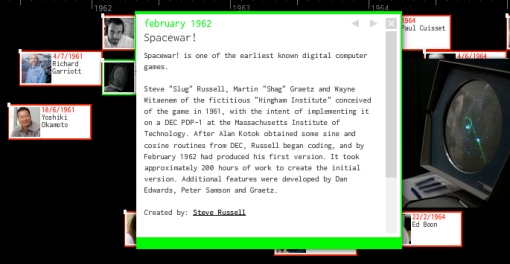
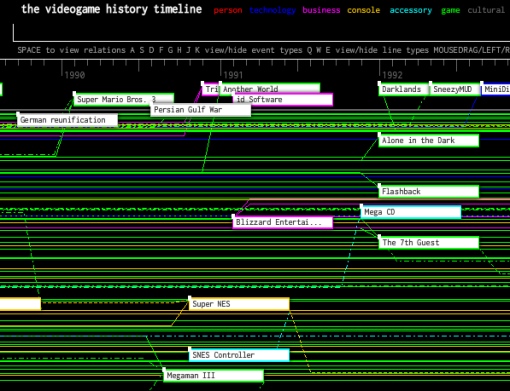
“Les deux” / “The Two”
[English follows…]
Mon générateur d’histoires “The Two” est désormais en ligne avec une traduction française, “Les deux” , de Serge Bouchardon. La version anglaise était auparavant disponible en Python. C’était le second de trois générateurs de 1k que j’avais réalisés à la fin de 2008. “Les deux” génère des histoires toutes simples de trois lignes, mais dont l’effet de sens n’est peut-être pas si simple. Les versions anglaise et française sont à présent disponibles en JavaScript et sont ainsi facilement accessibles sur le Web.
My story generator, “The Two,” is now online along with a French translation, “Les deux,” by Serge Bouchardon. The English version of the story was previously available in Python. It was the second of three 1k story generators that I wrote near the end of 2008. “The Two” generates three-line stories in a straightforward way, although the effect may not be straightforward. Both French and English versions are now available in JavaScript, so they can be run from the Web easily.
Digitally, Literally Yours
Here’s YouTube Doubler proof that letters and the digital can live together.
Also, Steve Reich, eat your heart out. And let it be a dish served cold.
Gatz
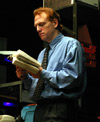
This play answers the question “what’s six and a half hours long, uses every word of The Great Gatsby as its text, and cannot be staged in New York?” Gatz is an admirable, extreme adaptation. Most of the words are spoken by Scott Shepherd, who reads Nick’s dialogue and his narration. A large cast voices other parts and also puts on effective dumbshows. On the empty space of the stage, a low-rent, aging office makes a second space which then is wittily made into a third, one which includes West Egg and Gatsby’s mansion. The set initially harbors a (broken) computer but is made to connect to the 1920s via windows, a swivel chair, and other elements. Actions are carried out before they are verbally narrated, so that the words sometimes become a sort of comical rimshot, anticipated by the actors; both actions and words get space of their own this way, too. The result, odd as it may seem, is both playful and faithful, capable of satisfying avant-garde theatergoers as well as great books enthusiasts.
A Note on the Word “Zork”
Yes, It’s a Nonsense Word
The lowdown on Zork‘s name, inasmuch as a lowdown has been provided in print, was given by authors Dave Lebling, Marc Blank, and Tim Anderson in 1979 in the article “Zork: A Computerized Fantasy Simulation Game,” Computer 12:4, 51-59 (April 1979):
The first version of Zork appeared in June 1977. Interestingly enough, it was never “announced” or “installed” for use, and the name was chosen because it was a widely used nonsense word, like “foobar.”
This is a clear explanation, but it raises the question of how this particular nonsense word came into wide use at MIT. It seems reasonable to pursue this question, and reasonable that there would be some discernable answer. After all, there’s a whole official document, RFC 3092, explaining the etymology of “foobar.” It could be interesting to know what sort of nonsense word “zork” is, since it’s quite a different thing, with very different resonances, to borrow a “nonsense” term from Edward Lear or Lewis Carroll as opposed to Hugo Ball or Tristan Tzara. “Zork,” of course, doesn’t seem to derive from either humorous English nonsense poetry or Dada; the possibilities for its origins are more complex.
Slouching from “Zorch”?
In the first part of “The History of Zork,” The New Zork Times 4:1 (Winter 1985), Tim Anderson adds to the earlier discussion and suggests a possible derivation for the word:
Zork, by the way, was never really named. “Zork” was a nonsense word floating around; it was usually a verb, as in “zork the fweep,” and may have been derived from “zorch.” (“Zorch” is another nonsense word implying total destruction.) We tended to name our programs with the word “zork” until they were ready to be installed on the system.
“Zorch” is listed in Peter R. Samson’s 1959 “TMRC Dictionary” – the dictionary of the Tech Model Railroad Club, an organization that was important in helping to begin and foster recreational computing. The term meant, at that time, “to attack with an inverse heat sink” – that is, to attack with a heat source – and is explained as “Another of David Sawyer’s sound effects, which I reinterpreted as a colorful variant of ‘scorch.'” It could also be imagined as a variant of “torch” – either way, the application of heat is suggested. This definition is consistent with the sense of “zorch” that Anderson gives, although a bit more specific. It is quite possible that “zork” does derive from “zorch,” as Anderson and others guess, but it is not clear why a word so derived would then be used as a placeholder program name. It’s also at least arguable that “zork” sounds less destructive than “zorch,” as the unintimidating back-formations “scork” and “tork” suggest. If that’s the case, why would a less intense term come to be used when the original term is more intense and very comical? While the “zorch” etymology might be right, it at least seems worthwhile to look to other possibilities.
Textbook Examples
“Zork” occurs occasionally, although rarely, as a proper name in various print sources in the decades leading up to 1977. Google Book Search reveals that some more nonsensical uses occur in some textbook examples in the 1970s. In Introduction to Experimental Psychology by Douglas W. Matheson, Richard Loren Bruce, and Kenneth L. Beauchamp (1970, 2nd. ed 1974) the meaningless “zork” model is introduced as a contrast to a medical model. “Zork” is also used as a fictional place name in Henry F. DeFrancesco’s 1975 Quantitative Analysis Methods for Substantive Analysts. There is some chance that the term was picked up from such a source. Zork explicitly pokes fun at the material nature of textbooks by including a “this space intentionally left blank” joke, which refers to a message sometimes printed on textbook’s blank pages to let readers know that they have not been left blank due to a printing error. Given this, it would be hard to rule out to possibility of the term “zork” coming from a textbook. Of course, the term could have appeared at MIT indirectly, in an example given in a lecture, on a problem set, or on a test, even if a book with the example in it was not assigned as a text. But there is nothing to strongly recommend this etymology, either. And while the former textbook example is clearly the more vivid, it is also much less likely to have been encountered by the Zork authors, [updated January 10] since they were involved with a computer science research group, Dynamic Modeling. MIT does not now have a department named psychology, but Course 9 (now Brain and Cognitive Sciences) was called Psychology from 1960-1985.
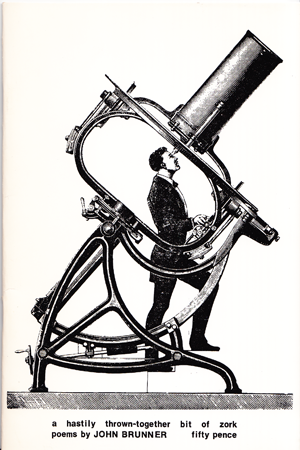
There has been some speculation – specifically, in this mailing-list thread – that the term “zork” may come to MIT via John Brunner, whose poetry chapbook A Hastily Thrown-Together Bit of Zork was published in 1974. Although the sense of the word as it appears in the title is completely consistent with the MIT meaning of the term, it is not clear that this 24-page pamphlet, published by Square House Books in an edition of 200 (50 numbered and signed), had made it to MIT by the time Zork coalesced, beginning in 1977. Nevertheless, the idea of a science-fictional vector for the term is appealing.
How Brunner Happened upon “Zork”
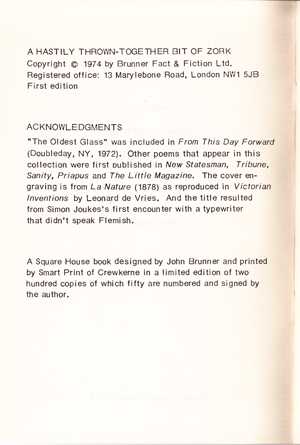
On the unnumbered second page of A Hastily Thrown-Together Bit of Zork, Brunner notes that “the title resulted from Simon Joukes’s first encounter with a typewriter that didn’t speak Flemish.” According to this history of Dutch and Flemish fandom, Simon Joukes was active in Flemish fandom and was a part of the club Sfan, helping to publish Info-Sfan, which became SF Magazine.

Here is a Belgian typewriter, manufactured by Olivetti. (This blog post is the source for the image.) The letters are laid out just as they are on a French typewriter, in the AZERTY scheme. As you can see, if you’ve learned to type the word “WORK” on a typewriter like this, and someone then substitutes a British (or US) typewriter without your noticing, and you then try to type that word without looking at the keys, you’ll type “ZORK.” (Since the “W” and “Z” are switched in this layout, the same thing would happen to a British typist who uses to a Belgian typewriter without noticing how the keys are labeled.)
It’s particularly appealing that this etymology makes zork an altered form of, or an alternative to … work.
Another Science-Fiction “Zork”
Brunner’s use of “zork” in the title of his book was not the first appearance of the word in science fiction. The word made an appearance earlier in Lin Carter’s novel The Purloined Planet, published in 1969. It was used in the name of an important character … “Zork Arrgh.”

It’s likely that Brunner at least glanced at the name of this key character. Lin Carter’s novel was published in a Belmont Double edition with “two complete science fiction novels.” The other was Brunner’s The Evil That Men Do.
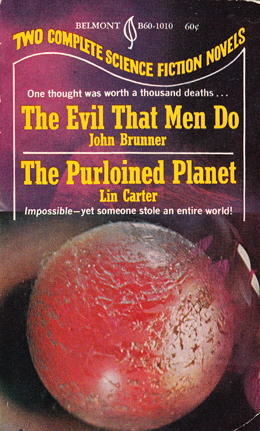
While Simon Joukes may have typed out the word “Zork” and directly inspired Brunner’s 1974 title, the word may have rang out to Brunner as interesting and particulaly amusing because of Carter’s earlier use of it.
“Zork” and How She Is Spoke
There is some chance that people at MIT saw Brunner’s slim book of poems, but it seems far from certain. As of this writing, WorldCat lists only four university libraries in the United States that have this limited-edition book. MITSFS, the MIT Science Fiction Society, boasts the world’s largest open-stack library of science fiction and has 83 titles by Brunner in its catalog – but A Hastily Thrown-Together Bit of Zork is not among these. The Evil That Men Do / The Purloined Planet is in the collection, however.
Even when all of these additional leads are considered, it seems there is no strong conclusion to be drawn about the deeper etymology of the name of MIT’s, and Infocom’s, most famous text adventure. “Zork” might have been a corruption or further development of “zorch.” It may have entered the argot because of its use in an amusing curricular example, perhaps thanks to Quantitative Analysis Methods for Substantive Analysts or another textbook that hasn’t yet been ingested into Google Books. Or, science fiction may have been the vector for the word. If it was, though, it seems likely that it made its way into MIT speech not because of Brunner’s book of poems, but thanks to Zork Arrgh, a key character in 1969 novel by Lin Carter, one that was sitting on the shelves at MITSFS.
Perhaps more evidence will come to light, and the origins of the word “zork” as it was used at MIT in the late 1970s will become clear. Or, it may be that the origins of the word are lost forever – obliterated in a nook of a subculture’s linguistic history that has been irreversibly zorched.
A Casual Revolution
Juul’s latest, like his Half-Real, offers many insights, particular and general, while being succinct and clear stylistically. The book is not just about matching tile games, although there’s a good chapter on them and their genealogy. It’s about the moment in the history of videogaming where games overflow their “hardcore” niche and begin to appeal to everyone. Juul describes the stereotypes of casual and hardcore games and players; then he demonstrates, using data from many interviews, exactly how they’re wrong. An important, high-level innovation involves figuring out how to study both games and players – in this case, to understand what exactly is meant by “casual games” and how much of what we associate with that has to do with “causal” modes of play. There’s also an excellent analysis of the social space of play in front of the screen, in Guitar Hero and Wii games. A Casual Revolution will be valuable for academics and those in industry, and will help keep the sun shining on games.
Micro Art Machines
Here are some tiny bits of code to generate some amusement and aesthetic value.
The album sc140 features 22 tracks, each one generated by no more than 140 characters of SuperCollider code. You can download 80 MB of MP3 (for the weak!) or grab the source code (less than 4 KB, with all the formatting) and, if necessary, install SuperCollider, which is free in every sense. Here’s a November New Scientist blog post about the album.
On the visual and literary side, check out Pall Thayer’s Microcodes, tiny art pieces in Perl. Thayer also offers a PDF guide to the appreciation of tiny programs. Some of Thayer’s program incorporate play with the human-legible dimension of code; “WAR has NO value,” now on the front page, is a simple and nice example of this.
IGF Finalists Announced
The 2010 Independent Games Festival finalists have been announced. Especially interesting to me are the finalists and honorable mentions for the IGF Nuovo Award, an award intended to “honor abstract, shortform, and unconventional game development which advances the medium and the way we think about games.” My collaborator, Ian Bogost, has a game in the finals: A Slow Year, a suite of four 1k games for one of his, and my, favorite platforms … which means that he’ll be brining an Atari 2600 to GDC this year to display his wares.


